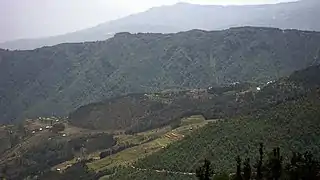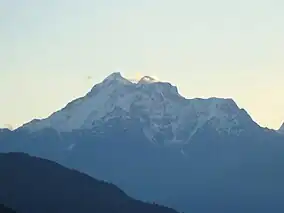Bhimeshwar
Bhimeshwar, (formerly Charikot), is a municipality in north-eastern Nepal and the headquarters of Dolakha District in Bagmati Province that was established in 1997 by merging the former Village development committees Charikot, Dolakha Town, Makaibari and Mati.[1] At the time of the 2011 Nepal census it had a population of 32,486 people living in 8,639 individual households.[2] The town is located at an altitude of 1554 metres (5101 feet).[3] The name of the district Dolakha came from Dolakha Town situated north-east of the headquarters Charikot Bazaar.
Bhimeshwor
भिमेश्वर | |
|---|---|
Municipality | |
 Landscape near Charikot; from North of the town | |
 Bhimeshwor Location in Nepal | |
| Coordinates: 27°40′0″N 86°2′0″E | |
| Country | |
| Province | Bagmati Province |
| District | Dolakha District |
| Government | |
| • Type | Mayor–council government |
| • Mayor | Mr. Ishwor Narayan Manandhar |
| • Deputy Mayor | Kamala Basnet |
| Population (2021) | |
| • Total | 40,000 |
| Time zone | UTC+5:45 (Nepal Time) |
| Postal code | 45500 |
| Area code | 049 |
| Website | http://bhimeshwormun.gov.np/en |
Boundaries
The region is bordered by the Sun Kosi River on the west and the Khimti Khola River on the east. It is divided unequally by the River Tama Koshi, proportionately two-thirds to the west of the river and one-third to the east.
To the north east lies the impressive Rolwaling Himal to the western edge of which are such peaks as Gauri Shankar and Melungtse. Gauri Shankar is synonymous with the god Shiva and his consort Parvati.
Geography
To the northwest the mountains slope gently downwards towards the ancient pass of Kuti that starts above the Tibetan town of Khasa and follows the waters of the Bhote Kosi from Tibet. The river flows past Kodari and Tatopani (Hot Springs) on the Nepalese side and gradually rushes down into an ever-widening stream of water that becomes the Sun Kosi.

The Khimti Khola drains down from a region of five lakes called Panch Pokhari. They have a specific place in legend and go by the names of Mohi (buttermilk), Jata (hair), Dudh (milk), Bahula (insane), and Bhut (ghost). People believe that if one bathes in Bahula Pokhari one will become insane, whereas the Ghost Lake cannot bear the smell of human perspiration and will pull one inside its murky waters to a certain death if you as much as venture near it. The Khimti Khola joins the Tama Koshi, as do the Khare Khola and Rolwaling Khola to the northeast and the Sangawati, Dolti and Charnewati Kholas to the west.
The riverine valleys open out into massive volcanic folds. Sub-tropical settlements on the banks of rivers boast banana trees, guava, and an abundance of fish. Above the banks hover the terraced fields of paddy, make, wheat, and millet.
Between Bhimeshwar and Jiri the road descends to 845 metres and is bordered by plantations of sugar-cane. Above these slopes are forests of dark oak, fir and pine, interspersed with tangles of bracken and fem all in the embrace of clinging orchids and coloured in the springtime by the rhododendrons, the national flower of Nepal.
Mosses cling to the shaded rocks and in the forests are wild strawberries, loganberries, red berries and thyme.
Destination
Dolakha is approximately 139 km from the Capital of Nepal, Kathmandu. Regular-Local and Express bus services are available from the Old Bus Station. All the Bus services are operated by Araniko Transportation Authority as per Syndicate System. Old Bus Park is situated opposite Play Ground-Tundekhel.

Students can get 45% discount in regular bus fare. Anyone can get a ride from virtually any spot in the route. Previously, one could ride in the hood but recently the law was passed not to allow anyone to ride over the hood.
The popular destination from Old Bus Park en route to Dolakha are many. Banepa, Dhulikhel, Dolal-Ghat, Lamo-Sangu (Long Bridge), Khadi Chaur (Middle Eastern Ground), and Mude. Tourists and local enjoy the travel and scenic views, foods on the route equally. Dolal-Ghat and Khadi Chaur are major destination for fish, Dolal-Ghat for vegetables (esp. tomatoes), Dhulikhel for restaurants and resorts.
Rafting in the Sunkoshi (Gold River) and Tamba koshi is also a major attraction.
Climate
| Climate data for Bhimeshwar (Charikot), elevation 1,940 m (6,360 ft) | |||||||||||||
|---|---|---|---|---|---|---|---|---|---|---|---|---|---|
| Month | Jan | Feb | Mar | Apr | May | Jun | Jul | Aug | Sep | Oct | Nov | Dec | Year |
| Average high °C (°F) | 13.5 (56.3) |
15.7 (60.3) |
20.1 (68.2) |
22.7 (72.9) |
23.1 (73.6) |
23.4 (74.1) |
22.9 (73.2) |
23.1 (73.6) |
22.2 (72.0) |
21.3 (70.3) |
17.8 (64.0) |
14.7 (58.5) |
20.0 (68.1) |
| Average low °C (°F) | 1.6 (34.9) |
2.9 (37.2) |
6.7 (44.1) |
10.2 (50.4) |
12.5 (54.5) |
15.0 (59.0) |
15.7 (60.3) |
15.3 (59.5) |
14.3 (57.7) |
10.9 (51.6) |
5.6 (42.1) |
2.4 (36.3) |
9.4 (49.0) |
| Average precipitation mm (inches) | 16.1 (0.63) |
23.0 (0.91) |
40.9 (1.61) |
77.2 (3.04) |
158.2 (6.23) |
313.4 (12.34) |
558.8 (22.00) |
529.8 (20.86) |
263.9 (10.39) |
65.7 (2.59) |
11.3 (0.44) |
16.4 (0.65) |
2,074.7 (81.69) |
| Source 1: ANU[4] | |||||||||||||
| Source 2: Agricultural Extension in South Asia (precipitation 1976–2005)[5] | |||||||||||||
Schools and colleges
Government schools
- Shree Kutidanda Higher Secondary School (Makaibari)
- Shree Kalinchwok Higher Secondary School (Charikot)
- Shree Pashupati Kanya Mandir (Charikot)
- Shree Bhim Higher Secondary School (Dolakha)
- Shree Sharba Secondary School (Jilu) [6]
- Shree Mahendradayo Higher secondary School (Mati)
Private boarding schools
- The Rising Star English Boarding School (Charikot)
- Mount Valley English Boarding School (Charikot)
- Tripura Glorious Academy (Charikot)
- Apline English Boarding School (Charikot)
- Aankura English Boarding School (Dharam Ghar)
- Gaurishanker English Boarding School (Charikot)
- Apex English Boarding School (Charikot)
- Kalinchowk English Boarding School (Charikot)
- Modern Nepal English School (Charikot)
Government college
- Gaurishankar Multiple Campus (Charikot)
- Charikot Campus (Charikot)
Private college
- HIMSE Academy (Charikot)
Government offices, Hospitals and Nursing Homes
Government
- District Education Office
- District Health Post
- Primary Health Centre
Private Hospitals
- Tsho Rolpa General Hospital and Nursing College
- Dirghau General Hospital
- Gaurishankar General Hospital (formerly under Korean aid)
Government offices
- Bhimeshwar Municipality Office
- District Public Health Office
- Road and construction Office
Demographics
At the time of the 2011 Nepal census, Bhimeshwar Municipality had a population of 33,324. Of these, 67.0% spoke Nepali, 13.7% Tamang, 10.4% Thangmi, 5.9% Newar, 1.2% Sherpa, 0.6% Maithili, 0.4% Bengali, 0.1% Bhojpuri, 0.1% Bhujel, 0.1% Gurung, 0.1% Hindi, 0.1% Jirel, 0.1% Magar, 0.1% Sunwar and 0.1% other languages as their first language.[7]
In terms of ethnicity/caste, 29.7% were Chhetri, 18.1% Newar, 15.6% Tamang, 12.6% Thami, 11.1% Hill Brahmin, 3.4% Kami, 2.0% Gharti/Bhujel, 1.8% Sarki, 1.3% Damai/Dholi, 1.3% Sherpa, 0.5% Magar, 0.3% Sanyasi/Dasnami, 0.3% Thakuri, 0.2% Badi, 0.2% Gurung, 0.1% Terai Brahmin, 0.1% Hajjam/Thakur, 0.1% Halwai, 0.1% Jirel, 0.1% Kathabaniyan, 0.1% Koiri/Kushwaha, 0.1% Musalman, 0.1% Rai, 0.1% Sunuwar and 0.5% others.[8]
In terms of religion, 76.4% were Hindu, 16.6% Buddhist, 5.6% Prakriti, 1.1% Christian, 0.1% Muslim and 0.1% others.[9]
In terms of literacy, 68.9% could read and write, 4.2% could only read and 26.8% could neither read nor write.[10]
Ethnic groups
Newars are mostly involved in small local business, Nepali in clothing stores.

Brahmins-Indo-Aryan; Referred to twice-born. They have been the dominant priestly cast of Nepal since Prithvi Narayan Shah of Gorkha unified the states of Nepal into a single Kingdom.
Jirel-Tibeto-Mongoloid; It is believed that they may be descendants of original inhabitants of Tibet and Tibetan tribes with whom they inter-married. Broadly speaking, Jirels have retained a Buddhist tradition. However, they employ Hindu Brahmins for many rituals. This behavior may date back to the Rana rule, a Hindu dynasty. They live in Jiri and the village nearby. They believe they originated as a result of trade between this region and the adjoining regions in Tibet. At death ceremonies, a Buddhist tradition prevails. However, for many domestic ceremonies they call a Brahmin priest and adhere to the Brahmanical tradition. This strange mixture can be explained by their mixed ethnic origins and that sometimes amongst certain of the middle-hill peoples there is no hard, dividing line.
Other- Ksehtri, Magar, Newar, Sherpa, Tamang, Thami
Media
To promote local culture Bhimeshwar has two community radio stations – Sailung (104 MHz) and Radio Kalinchowk (106.4 MHz).
References
- "भीमेश्वर नगरपालिका" (in Nepali). Archived from the original on 22 February 2013.
- "National Population and Housing Census 2011" (PDF). Central Bureau of Statistics. November 2017. Archived from the original (PDF) on 27 January 2018. Retrieved 1 October 2018.
- Charikot, Nepal Page
- "CLIMATES OF NEPAL AND THEIR IMPLICATIONS FOR AGRICULTURAL DEVELOPMENT" (PDF). Australian National University. Archived from the original (PDF) on 23 October 2023. Retrieved 27 October 2023.
- "TEMPORAL AND SPATIAL VARIABILITY OF CLIMATE CHANGE OVER NEPAL (1976-2005)" (PDF). Agricultural Extension in South Asia. Archived from the original (PDF) on 13 October 2023. Retrieved 27 October 2023.
- selected technical vocational School
- NepalMap Language
- NepalMap Caste
- NepalMap Religion
- NepalMap Literacy
